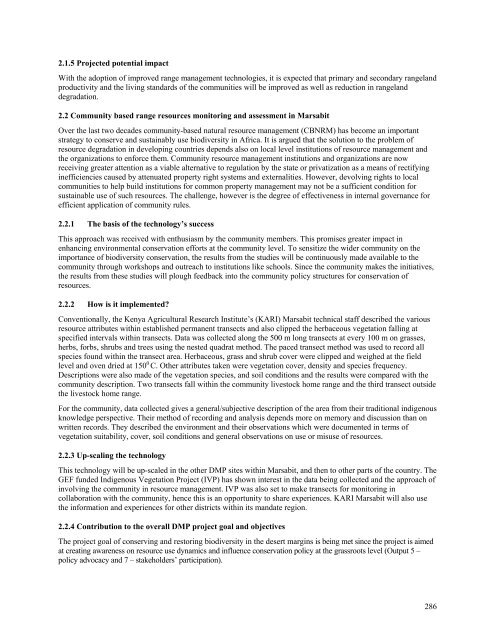ICRISAT Archival Report 2006 - The seedlings of success in the ...
ICRISAT Archival Report 2006 - The seedlings of success in the ...
ICRISAT Archival Report 2006 - The seedlings of success in the ...
Create successful ePaper yourself
Turn your PDF publications into a flip-book with our unique Google optimized e-Paper software.
2.1.5 Projected potential impact<br />
With <strong>the</strong> adoption <strong>of</strong> improved range management technologies, it is expected that primary and secondary rangeland<br />
productivity and <strong>the</strong> liv<strong>in</strong>g standards <strong>of</strong> <strong>the</strong> communities will be improved as well as reduction <strong>in</strong> rangeland<br />
degradation.<br />
2.2 Community based range resources monitor<strong>in</strong>g and assessment <strong>in</strong> Marsabit<br />
Over <strong>the</strong> last two decades community-based natural resource management (CBNRM) has become an important<br />
strategy to conserve and susta<strong>in</strong>ably use biodiversity <strong>in</strong> Africa. It is argued that <strong>the</strong> solution to <strong>the</strong> problem <strong>of</strong><br />
resource degradation <strong>in</strong> develop<strong>in</strong>g countries depends also on local level <strong>in</strong>stitutions <strong>of</strong> resource management and<br />
<strong>the</strong> organizations to enforce <strong>the</strong>m. Community resource management <strong>in</strong>stitutions and organizations are now<br />
receiv<strong>in</strong>g greater attention as a viable alternative to regulation by <strong>the</strong> state or privatization as a means <strong>of</strong> rectify<strong>in</strong>g<br />
<strong>in</strong>efficiencies caused by attenuated property right systems and externalities. However, devolv<strong>in</strong>g rights to local<br />
communities to help build <strong>in</strong>stitutions for common property management may not be a sufficient condition for<br />
susta<strong>in</strong>able use <strong>of</strong> such resources. <strong>The</strong> challenge, however is <strong>the</strong> degree <strong>of</strong> effectiveness <strong>in</strong> <strong>in</strong>ternal governance for<br />
efficient application <strong>of</strong> community rules.<br />
2.2.1 <strong>The</strong> basis <strong>of</strong> <strong>the</strong> technology’s <strong>success</strong><br />
This approach was received with enthusiasm by <strong>the</strong> community members. This promises greater impact <strong>in</strong><br />
enhanc<strong>in</strong>g environmental conservation efforts at <strong>the</strong> community level. To sensitize <strong>the</strong> wider community on <strong>the</strong><br />
importance <strong>of</strong> biodiversity conservation, <strong>the</strong> results from <strong>the</strong> studies will be cont<strong>in</strong>uously made available to <strong>the</strong><br />
community through workshops and outreach to <strong>in</strong>stitutions like schools. S<strong>in</strong>ce <strong>the</strong> community makes <strong>the</strong> <strong>in</strong>itiatives,<br />
<strong>the</strong> results from <strong>the</strong>se studies will plough feedback <strong>in</strong>to <strong>the</strong> community policy structures for conservation <strong>of</strong><br />
resources.<br />
2.2.2 How is it implemented?<br />
Conventionally, <strong>the</strong> Kenya Agricultural Research Institute’s (KARI) Marsabit technical staff described <strong>the</strong> various<br />
resource attributes with<strong>in</strong> established permanent transects and also clipped <strong>the</strong> herbaceous vegetation fall<strong>in</strong>g at<br />
specified <strong>in</strong>tervals with<strong>in</strong> transects. Data was collected along <strong>the</strong> 500 m long transects at every 100 m on grasses,<br />
herbs, forbs, shrubs and trees us<strong>in</strong>g <strong>the</strong> nested quadrat method. <strong>The</strong> paced transect method was used to record all<br />
species found with<strong>in</strong> <strong>the</strong> transect area. Herbaceous, grass and shrub cover were clipped and weighed at <strong>the</strong> field<br />
level and oven dried at 150 0 C. O<strong>the</strong>r attributes taken were vegetation cover, density and species frequency.<br />
Descriptions were also made <strong>of</strong> <strong>the</strong> vegetation species, and soil conditions and <strong>the</strong> results were compared with <strong>the</strong><br />
community description. Two transects fall with<strong>in</strong> <strong>the</strong> community livestock home range and <strong>the</strong> third transect outside<br />
<strong>the</strong> livestock home range.<br />
For <strong>the</strong> community, data collected gives a general/subjective description <strong>of</strong> <strong>the</strong> area from <strong>the</strong>ir traditional <strong>in</strong>digenous<br />
knowledge perspective. <strong>The</strong>ir method <strong>of</strong> record<strong>in</strong>g and analysis depends more on memory and discussion than on<br />
written records. <strong>The</strong>y described <strong>the</strong> environment and <strong>the</strong>ir observations which were documented <strong>in</strong> terms <strong>of</strong><br />
vegetation suitability, cover, soil conditions and general observations on use or misuse <strong>of</strong> resources.<br />
2.2.3 Up-scal<strong>in</strong>g <strong>the</strong> technology<br />
This technology will be up-scaled <strong>in</strong> <strong>the</strong> o<strong>the</strong>r DMP sites with<strong>in</strong> Marsabit, and <strong>the</strong>n to o<strong>the</strong>r parts <strong>of</strong> <strong>the</strong> country. <strong>The</strong><br />
GEF funded Indigenous Vegetation Project (IVP) has shown <strong>in</strong>terest <strong>in</strong> <strong>the</strong> data be<strong>in</strong>g collected and <strong>the</strong> approach <strong>of</strong><br />
<strong>in</strong>volv<strong>in</strong>g <strong>the</strong> community <strong>in</strong> resource management. IVP was also set to make transects for monitor<strong>in</strong>g <strong>in</strong><br />
collaboration with <strong>the</strong> community, hence this is an opportunity to share experiences. KARI Marsabit will also use<br />
<strong>the</strong> <strong>in</strong>formation and experiences for o<strong>the</strong>r districts with<strong>in</strong> its mandate region.<br />
2.2.4 Contribution to <strong>the</strong> overall DMP project goal and objectives<br />
<strong>The</strong> project goal <strong>of</strong> conserv<strong>in</strong>g and restor<strong>in</strong>g biodiversity <strong>in</strong> <strong>the</strong> desert marg<strong>in</strong>s is be<strong>in</strong>g met s<strong>in</strong>ce <strong>the</strong> project is aimed<br />
at creat<strong>in</strong>g awareness on resource use dynamics and <strong>in</strong>fluence conservation policy at <strong>the</strong> grassroots level (Output 5 –<br />
policy advocacy and 7 – stakeholders’ participation).<br />
286

















